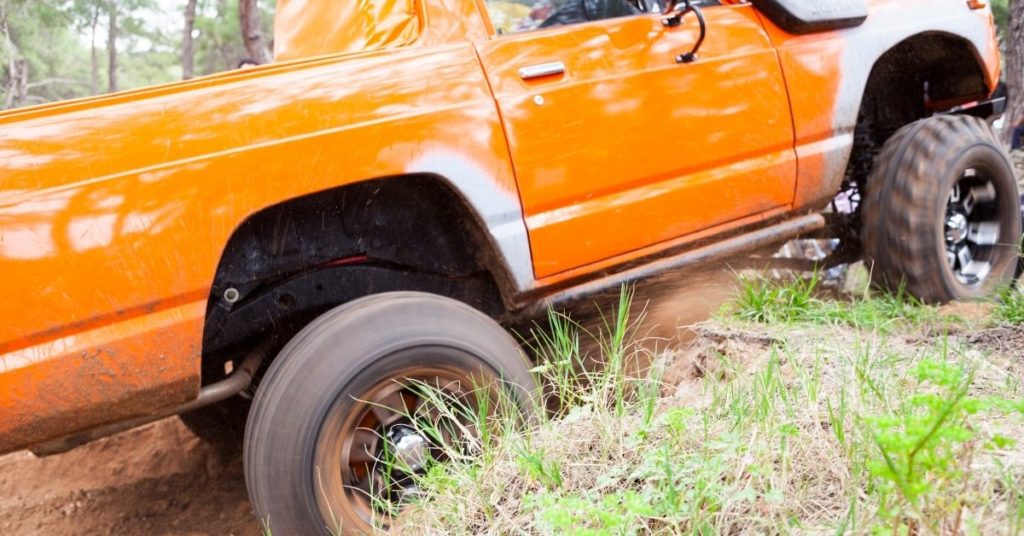The tires that you fit to your four-wheel drive can make a dramatic difference to the performance and capability of your vehicle. 33 and 35 inch tires are two of the most common options for those looking to drive off-road.
33-inch tires are the better choice for most people, they are big enough for most overlanding and off-roading trails. 35-inch tires are for vehicles that are mostly dedicated to off-road and don’t spend much time on the paved surface. These tires are suitable for dedicated rock crawling rigs, etc.
Differences between 33 and 35 Inch tires
Before we begin looking at 33 and 35 inch tires it’s important that you have a basic understanding of what these measurements actually mean. When tire sizes are altered there can be many impacts on the physical features of the tire and its overall performance.
Different sizes of tires have different measurements in terms of:
- The diameter (the distance across the center of the tire).
- The width or depth.
- The sidewall (strip between the rims and the outer tread).
- The circumference (the measurement of the outside arc all the way around the tire).
- How many revolutions/ rotations per mile that the tire experience.
- There are also certain things that tire size will impact in terms of performance including:
- Clearance of the vehicle: bigger (in this case 35 inch) tires typically can increase your clearance helping you overcome larger obstacles.
- The traction: increased traction can lead to better fuel consumption and more off-road capabilities. Generally larger tires (e.g. 35 inch ones) will have more traction but tread also plays an important role.
- The performance, handling, and maneuverability of your vehicle. Generally, 33 inch tires will be best in these regards.
Before you begin sorting through the options available for your vehicle it’s important you have a strong grasp of what aspects of these characteristics are important to you.
By having an awareness of your number one priority (e.g., clearance, performance, fuel economy) you will simplify the process of selecting a tire and decrease the stress of the tire selecting process.
Traction
Traction is a key consideration for those looking to make the most out of their four-wheel drives. It gives your car the grip to overcome challenging terrains like mud, rocks, and sandy soil.
Tire size can have a dramatic difference in terms of the effectiveness of the tread of the tire. The tread may be specialized for terrains, however, larger tires will enhance the function of the tread.
The ‘footprint’ of the tire will be a little longer and spread further on larger tires. This creates more void space between each element of the tread which is essential to help your car maintain its momentum over more difficult terrains. It essentially ensures that more of the pattern is in contact with the grounds at all times.
Larger tires also provide more traction because there is a greater surface area of tires on the ground. Therefore, if you are looking for a tire to help you gain maximum traction opt for the 35 inch option where possible.
The 35 inch tire is the winner in this department.
Fuel Economy
Another key component of running your tires is ensuring that you get maximum value for money with the product. Fuel economy is a key aspect of value for money and can vary widely between different tire sizes.
Fuel consumption increases when your car sends extra torque (power) to the wheels of your car. This extra torque can be the result of a lack of traction, extra weight, or difficult terrain in general. In order for the extra power to be generated your car needs to burn more fuel, meaning the more torque sent to the wheels the lesson value for money you get in terms of fuel economy.
Smaller tires weigh less because they are made with less rubber than their larger counterparts. This means that 33 inch tires will consume less fuel and may prove a more economical option to use in the long run.
The 33 inch tire wins here.
Clearance

The height of your vehicle can go a long way towards getting you out of tough situations when you are offroading. You can add clearance to your vehicle by installing a lift kit which may be needed regardless of if you select 33 or 35 inch tires depending on your vehicle.
For every two inches of tire size, your car will be provided with an extra inch of clearance. While this may not sound like a whole lot it can go an exceptionally long way in terms of your vehicle’s off-road capabilities.
If you are looking to go on harsher tracks or to use the vehicle for its offroad capabilities 35 inch tires will give you better performance in most offroad situations. In saying that 33 inch tires will still be just as capable in 99% of situations and are still a great option for your four-wheel drive.
The 35 inch tire wins this one.
Performance
Wheels are an important consideration if you are looking for maximum speed, power, and performance. The power and momentum of your car can also be a big influence over what tracks you can and cannot drive.
33 inch tires are better for those looking for better power and it takes less energy to rotate them. This increases the efficiency of your take off as well as the speeds you can reach in your vehicle over all terrains. In terms of performance 33 inch tires are also more effective as they are more responsive in terms of steering and your control of the vehicle.
33 inch tires are better here.
Stability
Stability is a major factor in the amount of comfort you have in your cab. It will also increase the ease with which you maintain your safety and control in certain terrains including as you are going over steep rock steps.
35 inch tires offer maximum stability in these situations.
The 35 inch tire is better here.
Price
For most price will be a major concern leading into purchasing your tires. It can often be hard to find room in the budget for quality tires and you may have constraints in terms of what you can afford to purchase.
The larger the tire the more expensive they will be in terms of both the upfront costs of the tires and the modifications you need to make to your vehicle including lift kits, altering the gearing of your car, cutting mud guards to make the tires fit.
Therefore, the smaller 33 inch tire is a more economic option as it costs less upfront (being made from less materials) and less modifications are needed to your vehicle. These tires will typically be sold for around $200-$300. This is apposed to the $300-$400 or so you would need to spend if you were to buy 35 inch tires.
The 33 inch tire is better in price.
Terrain
The terrain you most frequently drive in may also influence your decision when buying your wheel. Not only do you need to select a tread that works best for this terrain but different sized tires can dramatically impacting your vehicle’s offroad capabilities.
We have compiled a list of different terrains that you may encounter and explained what tire has been tested and proven better by four-wheel drivers below.
Sand- both 33 and 35 inch tires are perfectly fine at driving in sand. However, 33 inch tires give the car more power and a smoother ride across sand which makes the driving experience more pleasant and efficient.
Ruts- clearance is a major consideration when driving over ruts. The 33 inch wheel offers sufficient clearance for most ruts but the 35-inch wheel is more effective at avoiding scraping and providing a more stable, steady ride over them.
Rock step- the 35 inch is a clear winner for overcoming larger rock steps. The extra clearance really is essential for this terrain.
Mud- mud is one of the most common but difficult terrains. 33 inch tires perform adequately in mud especially as they can help you enter with more montemum.
However, 35 inch tires ensure that more of the footprint of the tire is in contact with the ground providing better traction for overcoming bog pits. The extra clearance 35 inch tires provide also stops the car from getting snagged and losing its momentum in mud.
Highway- its highly likely that your four-wheel drive will spend at least some of its time driving on paved roads and highways. Its important for your safety and comfort that you choose a tire that is good for this kind of driving, especially if you intend to use your four-wheel drive as a normal car e.g. taking it to work.
In terms of highway performance, 33 inch tires offer more agility and better braking. The 35 inch tires were still reasonably adept but overall the 33 inch seem to handle highway conditions better.
This one is a draw, as it depends on how you will use the tire.
Overview of 33 Inch Tire
To help provide a clear indication of which wheel to choose we have compiled a clearer list of pros and cons surrounding purchasing a 33 inch tire.
- Weighs less
- Better fuel economy
- Better power
- Better performance
- Cheaper
- Will handle 99% of four-wheel drive tracks without difficulty
- Better for highway driving
- Provides less clearance than 35-inch tires
- You may need to remove your front mud flaps and make other modifications
- Will throw your speedometer off
As a minor note these tires may throw off your speedometer at a rate that increases exponentially as you gain more speed which is something you should be wary of to avoid speeding tickets or other issues with the law.
Overview of 35 Inch Tires
Like above here is a more concise overview of the pros and cons of purchasing 35 inch tires.
- More clearance
- Better traction
- Better stability
- Better performance off-road
- Better for more extreme four-wheel drive terrains including mud, ruts, and rock steps
- More expensive
- Heavier
- Worse fuel consumption
- Will need more modifications to fit to most cars
- A lift kit will be absolutely necessary
- Extra weight adds strain on driveterrain parts
The extra performance of these tires does come at a significant cost. Not only does this option cost more upfront but it can also wear out many of the drivewear components of your car causing frequent replacements. These drivetrain components may include your diffs, wheel bearings, and suspension.
The modifications you will need for this style of tire can also be quite costly so this option may not be viable for those who are looking for a more affordable enhancement for their four wheel drive.
So Which is Better?
Which option is better to purchase depends entirely on your needs. Both are definitely awesome options for those looking to enjoy off-road tracks. Either option is a perfectly valid choice, in order to decide which option is better you need to have a clear awareness of exactly what you are looking to get out of the tire and how much money you can afford to invest.
The 33 inch tire is an excellent option for those looking for to use their four-wheel drive to use around town and occasionally on four-wheel drive tracks. If you do not intend to go on particularly arduous tracks these can handle pretty much anything you throw at them. They are also much cheaper and better for those looking for great four-wheel drive tire on a tighter budget.
If money is no object the 35 inch tire will help you make the absolute most out of your vehicle off-road. With this size fitted the world is your oyster in terms of four-wheel drive tracks. It is amazingly capable for almost all terrains that you will encounter.
For overlanding the 33 inch tire would be a better option as you spend a considerable amount of time on main roads and highways. Another thing to consider for overlanding is the accessibility of tires, not many places will carry larger tires, and a 33 inch tire may be easier to find in an emergency than a 35 inch tire.
Before you Purchase Your Tires
Before you begin scouring the market for quality 33 or 35 inch tires we have a few final points to help you make the most out of your tires. These tips will improve your efficiency as you begin to consider all of the amazing and less so amazing products out there for you to choose from.
- Budget: tires are one of the most heavily used components of your car, we encourage you to try and free room in your budget to purchase high quality, first-hand set of tires.
Spending a little extra can go a long way into what you get out of the tire and the better-quality tire you purchase the less you’ll have to replace them! For those on a tighter budget, 33 inch tires will suit your needs better than 35 inch ones will. - Tread: tires are designed with many different tread patterns to provide traction on many unique terrains. While tires for other terrains may appear cheaper it really is best to choose a tire that is designed to work best under the terrain you will most likely be driving in (e.g., if you drive somewhere that rains a lot get a tread that works for mud if you live somewhere that snows a lot look for snow tires).
If you are just looking for a tire for all general conditions then we advise you to look into “all-terrain” tires which are the best all-rounders perfect for those who like to travel cross country across all kinds of different terrains. - 35 inch tires will enhance the effectiveness of your tread by improving your tread ‘footprint’. The larger size of the tire creates more space in the pattern of the tread ensuring it more of the pattern comes into contact with the ground at the same time giving you better traction and capability.
- Buy name brand: this aligns with your budget. Buy name brands that have a good reputation as they will have the best quality products in order to maintain their well-earned reputation. No matter which tire size you choose this is a sure fire way to ensure that you get value for your money and are not left disappointed after all the time you have spent researching the topic.
Conclusion
33 inch tires are more economical options for those who are looking to dive on more mainstream roads and easy tracks. 35 inch tires are great for those looking to go further off the beaten track and tackle more treacherous terrains.
No matter which way you go ensure you look for a tire from a reputable brand with a tread that suits the terrain that you will be driving in most. The more love and money you invest in your tires the longer they will last you!
- Tips and tricks For Setting Up Camp Like a Pro - September 11, 2023
- The Best Multi-Tools for Overlanding Adventures - August 25, 2023
- Off-Road Navigation Tips for Overlanders - August 13, 2023


